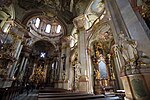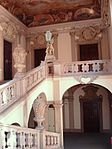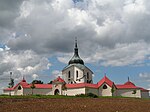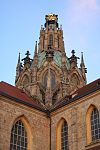Czech Baroque architecture

Czech Baroque architecture refers to the
The
The spread of the
Many of the Baroque architects who worked, lived and often also died in the Czech lands came from different countries or were of foreign origin, mainly Italian, some came also from Bavaria, Austria or France.
From Late Renaissance and Mannerism to Early Baroque

The Baroque style penetrated Bohemia in the first half of the 17th century.
Among these transitional buildings is the Italian chapel consecrated to the
The Matthias Gate of the Prague Castle, built before 1614 probably by Giovanni Maria Filippi is traditionally designated the first Baroque structure in Prague.[4]
Early Baroque

The clear Baroque style came to the Crown of Bohemia during the Thirty Years' War (1618–1648) when it finally replaced the Renaissance style. The Baroque style, coming from Catholic Italy, was strongly supported by the rich Catholic aristocracy and the Catholic church, which became the only legal church after 1627.
The architects of early Baroque in the Czech lands were foreigners, mostly Italians.
The first Baroque palace in Prague and probably also the first in Central Europe[5] was built in 1621–1630 for a Czech nobleman, general of the imperial army in the Thirty Years' War, Albrecht von Wallenstein. Wallenstein Palace (Czech: Valdštejnský palác) was designed and built by Italian architects Giovanni Pieroni and Andrea Spezza and was inspired by the newest Italian architecture of its time but the influence of Mannerism can also be seen.
The
Very important architect of the early Baroque style in Prague was
In the early Baroque style was renovated the residence of the
Jean Baptiste Mathey was an important French architect who worked in the Crown of Bohemia. His works include the Church of St. Francis Seraph in the Old Town of Prague and Troja Palace, built near Prague for count of Sternberg. He also rebuilt the Archbishop's Palace in Prague. His works prefigure the High Baroque style in the Czech lands.
-
The front facade of the Church of the Holy Savior by Carlo Lurago, 1650s–1660s.
-
The front facade of Clementinum by Carlo Lurago, 1650s–1660s.
-
The Humprecht Chateau by Carlo Lurago, 1666–1668.
-
Kroměříž Archbishop's Palaceby Filiberto Lucchese, 1660s.
-
Černín Palace by Francesco Caratti, 1660s–1680s.
-
Troja Palace by Jean Baptiste Mathey, 1679–1685.
-
Church of St. Francis Seraph in the Old Town of Prague by Jean Baptiste Mathey, 1679–1688.
-
Church of St. Margaret in Jaroměřice nad Rokytnou, late 17th century.
High Baroque

The High Baroque period in the Czech lands begins around the year 1690 and lasts to the mid-18th century. The architects of this time were mostly born in Bohemia or Moravia but often were of foreign origin. The most significant architects of this period were
Other important high Baroque architects in the Crown of Bohemia were
One of the most precious high Baroque secular buildings in Prague is the
.In Prague there are also fine high Baroque terraced palace gardens below the Prague Castle in the Malá Strana of Prague: Ledebur Garden, Small and Great Palffy Gardens, Kolowrat and Small Fürstenberg Gardens. Another important terraced garden in the Malá Strana district is the Vrtba Garden.
In 1714–1754 the
-
Holy Trinity Column in Olomouc
-
The iconic radical baroque space -Basilica Virgin Mary in Křtiny, Moravia
-
The interior of St. Nicholas Church in the Lesser Town of Prague, 1750s–1760s.
-
Church of St. John of Nepomuk in the New Town of Prague by Kilian Ignaz Dientzenhofer, 1730s.
-
The front wall ofson Dientzenhofer, 1666–1668
-
Mnichovo Hradiště Chateau by Marco Antonio Canevalle, 1690s–1720s.
-
Staircase of the Clam-Gallas Palace in Prague by J. B. Fischer von Erlach, 1714–1718.
-
Vranov nad Dyjí Chateau with dome by J. B. Fischer von Erlach, early 18th century.
Baroque Gothic
The Baroque Gothic style is a unique strand of Czech High Baroque art which connects the Bohemian Radical Baroque style with Gothic elements. The creator and main representative of this style was the Bohemian architect Jan Santini Aichel.
The Pilgrimage Church of Saint John of Nepomuk built in 1720s in this style by Jan Santini Aichel can be found on the UNESCO World Heritage List.
-
Pilgrimage Church of Saint John of Nepomuk at Zelená hora near Žďár nad Sázavou built in 1720s
-
Dome of the church in Kladruby by Jan Santini Aichel, 1712–1726.
-
Church in the Želiv monastery by Jan Santini Aichel, 1714–1721
-
Church in Roudnice nad Labem by Octavio Broggio.
-
Wooden Baroque Gothic furnishings of the St. Gallus Church (kostel sv. Havla) in Poříčí nad Sázavou by Lazar Widemann, 1740s.
Late Baroque and Rococo

The late Baroque style was usual in the Crown of Bohemia during the reign of queen
The examples of the late Baroque architecture (with Rococo elements) in Prague are the Archbishop's Palace or the Goltz-Kinsky Palace on the
See also
References
- ISBN 9788073605773.
- ISBN 80-86161-38-2.
- ^ "Královská cesta (Royal route in Prague)". Archived from the original on 2020-08-24. Retrieved 2013-05-09.
- ISBN 80-86161-61-7.
- ISBN 978-80-254-9201-7.)
{{cite book}}: CS1 maint: multiple names: authors list (link - ISBN 978-80-7321-651-1.
- ISBN 978-80-85970-74-6.























